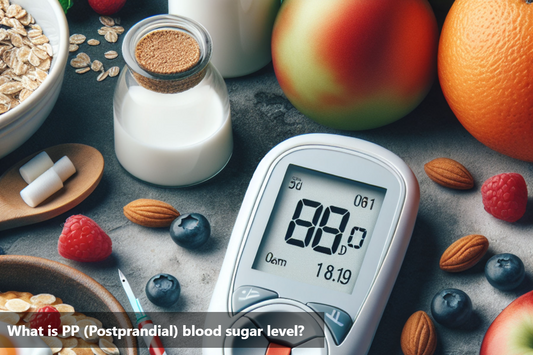Blood sugar levels, also known as glucose levels, are the amount of sugar in the blood. Glucose is the main source of energy for the body's cells and is important for the brain, muscles, and other body parts to work well. It's crucial to understand blood sugar levels for overall health because they affect how much energy we have and how our body works. As we get older, our bodies may change how they control blood sugar, so it's important to know the normal levels for different age groups. Exploring this idea can help us understand why it's important to be aware of age-specific blood sugar levels and what it means if there are differences.
|
Age |
Normal fasting glucose without diabetes |
Target glucose range for type 1 diabetes before meals |
Target glucose range for type 1 diabetes at bedtime |
|
Adults and children 13-19 |
70-100 mg/dL |
90-130 mg/dL |
90-150 mg/DL |
|
Children 6-12 |
70-100 mg/dL |
90-180 mg/DL |
100-180 mg/DL |
|
Children under 6 |
70-100 mg/dL |
100-180 mg/DL |
110 to 200 mg/DL |
How Is Blood Sugar Tested?
When it comes to testing blood sugar, there are several methods that can be utilized. Some of the common methods include:
-
Glycated Hemoglobin (A1C) Test: This test measures your average blood sugar level over the past two to three months.
-
Fasting Blood Sugar Test: This test measures your blood sugar level after an overnight fast.
-
Oral Glucose Tolerance Test (OGTT): This test measures your blood sugar level before and after drinking a sugary solution.
-
Random Blood Sugar Test: This test measures your blood sugar level at a random time.
-
Continuous Glucose Monitoring (CGM): This method involves wearing a device that continuously monitors your blood sugar levels throughout the day.
The choice of testing method depends on various factors including the patient's medical history, symptoms, and the healthcare provider's recommendation. It's important to work closely with your healthcare team to determine the most appropriate method for monitoring your blood sugar levels.
Factors Affecting Blood Sugar Levels
-
Age: As we age, our bodies may become less efficient at processing sugar, leading to higher blood sugar levels.
-
Diet: Consuming a balanced diet with moderate carbohydrate intake can help stabilize blood sugar levels.
-
Exercise: Regular physical activity is essential for regulating blood sugar levels, as exercise helps the body use sugar for energy and makes cells more sensitive to insulin.
-
Overall Health: Conditions like obesity and high blood pressure can impact blood sugar levels.
-
Stress: Stress can lead to fluctuating blood sugar levels as hormones like cortisol and adrenaline are released, causing the liver to produce more glucose. It's important to manage stress through relaxation techniques and mindfulness practices.
Why Blood Sugars Matter in Diabetes
Blood sugar levels play a crucial role in managing diabetes. The body’s inability to regulate blood sugar levels can lead to serious health complications. Hence, individuals with diabetes need to monitor and control their blood sugar levels through medication, diet, and lifestyle changes. By maintaining blood sugar levels within the target range, individuals can reduce the risk of developing diabetic complications such as nerve damage, heart disease, and kidney problems. Therefore, staying mindful of blood sugar levels is a vital aspect of managing diabetes effectively.
To conclude:
Understanding the right blood sugar levels for your age is really important for staying healthy. It helps you check and control your blood sugar, which lowers the chance of having health problems. Knowing what the normal blood sugar levels are for people of different ages helps you make smart choices about how you live, eat, and exercise to keep your blood sugar at a good level. Plus, knowing the right blood sugar levels for your age means you can spot any issues early and get help if you need it. This can really help stop problems caused by unstable blood sugar levels. In short, knowing the right blood sugar levels for your age gives you the power to make good choices for your health. When you understand these levels and how important they are, you can focus on staying healthy and feeling good all the time.
FAQs:
-
Q: At what age should I start monitoring my blood sugar levels? A: It is recommended to start monitoring your blood sugar levels from the age of 40, and at a younger age if you have a family history of diabetes.
-
Q: What are the normal blood sugar levels for different age groups? A: Normal blood sugar levels vary by age, but generally range from 70 to 100 mg/dL for fasting blood sugar and less than 140 mg/dL two hours after eating.
-
Q: How does blood sugar levels change as we age? A: Blood sugar levels tend to rise with age, so it's important to monitor and manage your blood sugar levels as you get older to prevent diabetes and other health complications.
-
Q: What are the risk factors for high blood sugar levels at different ages? A: Risk factors for high blood sugar levels include unhealthy diet, lack of physical activity, obesity, genetics, and certain medical conditions. These factors can affect individuals of all ages.
-
Q: How often should I check my blood sugar levels as I get older? A: It is recommended to check your blood sugar levels regularly, especially if you are over the age of 40 or if you have risk factors for diabetes. Speak with your healthcare provider to determine the best frequency for monitoring.
This Blog post is an initiative by DiabeSmart, to provide accurate and Nutritionist / Doctor approved information related to Diabetes. DiabeSmart is India's first Food brand designed specifically for Diabetics, that has been clinically tested on Diabetics and Pre-Diabetics to deliver 55% - 70% lower Sugar spikes. DiabeSmart is part of Lo! Foods - India's leading brand for Everyday Functional Health foods.















